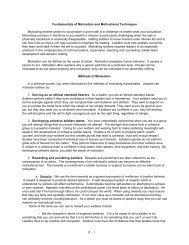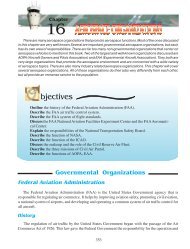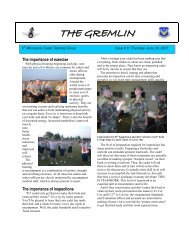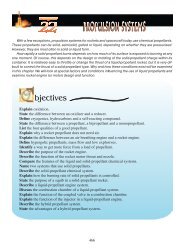LEARN TO LEAD - Civil Air Patrol
LEARN TO LEAD - Civil Air Patrol
LEARN TO LEAD - Civil Air Patrol
Create successful ePaper yourself
Turn your PDF publications into a flip-book with our unique Google optimized e-Paper software.
ees for a couple of reasons: One, it's the right thing to do,and two, it's good for business. And most companies canuse every possible edge these days."He cites the benefits of a work culture of free-flowing information:a greater connection by staff to the financialbig picture, reduced complacency, more creative solutions,and "organizational consistency and stability andfaster, more-efficient execution." All of that helps organizationscompete, especially in a weak economy, he says.Bennis agrees that a workplace that recognizes the soundbusiness case for transparency is essential for leaders tosurmount the challenges of crafting a relevant strategy."In the long run it would be an enormous advantage foran organization," he says. "The difficulties are that [atransparency policy] would have to be adjusted to eachorganization [because it] has enormous implications fortheir ethics and values, and how those are enforced. …Given the fact that inside of organizations are thingsgoing on that the public should know about, [stakeholders]are not shutting up."Associations Open UpSome associations have looked to transparency as a wayto push their mission, build donor trust, boost engagementand dialogue with members, address regulator concerns,and modernize their risk-management strategies.• The Washington State Hospital Association and itsmember hospitals launched a webpage called "HospitalTransparency" to help consumers make healthcare decisions,learn about costs and quality measurements of hospitalcare, and identify nearby facilities and financialassistance options.• The Oregon Association of Hospitals and Health Systemspartnered with the Office of Health Policy and Researchto release a report in May 2010 that makes publicthe hospital-acquired infection rates of health facilities inthe state. According to Steve Gordon, Ph.D., of the association'squality committee in The Lund Report, "the intentis to be transparent" and "to use [the report] as a foundationfor continued prevention."• The National Association of Corporate Directors usedtransparency to promote the value of its programs, publiclyreaffirming the importance of and its commitment to directoreducation: "At a time when new SEC disclosure rulescall for greater transparency of board member qualifications… [we] will continue to provide the industry's leadingcertificate-based director education and in-boardroomservices for the largest and most complex companiesaround the world, as well as all publicly traded, private,and nonprofit companies."• ASCD (formerly the Association for Supervision andCurriculum Development) has turned to the virtual platformSkype to support more inclusive, open meetings ofits Scholars Team, whose 25 members reside on six continents.The free tool can record meetings, so ASCD canoffer them archived online later.• International relief nonprofit World Vision and othersissued frequent updates to donors and media about theexact uses and on-the-ground impacts of the millions ofdollars donated after the Haiti earthquake in January 2010.SEVEN STEPS <strong>TO</strong> A MORETRANSPARENT ORGANIZATIONHere's how you can create a more transparent organization:1. Make sure senior leadership is aligned. Does everyonesee the external environment the same way? Does everyoneunderstand organizational goals and plans? Doeseveryone agree on what success looks like? If not, it's timeto remedy the situation."Alignment is most important at the senior level becauseall information cascades downward from it," says Studer."If one senior leader is out of sync with the others, theneveryone under her is going to be out of sync."2. Close the perception gap between senior leadershipand middle managers. Senior leaders generally have aclear grasp of the issues facing the organization. They aresteeped in these issues every day. Mid-level managersdon't always see things the same way. The only solution isfor senior leaders to relentlessly communicate the issuesto them."You can address these issues in supervisory sessions,"suggests Studer. "You can hold regular meetings withmid-level managers. You can send out email alerts thatlink to news items driving high-level decisions. If you're asenior leader, it's critical to make sure the people underyou understand the big-picture issues and their implications.It's one of the most important parts of your job."3. Help people understand the true financial impact ofdecisions. Get comfortable framing all major decisions ineconomic terms. If a manager wants to spend money onsomething—a new program, a new position—she needs tobe prepared to explain in financial terms how it will payoff for the company. Staff, too, need to understand thereal cost of mistakes or lapses in productivity as well asthe potential positive impact of doing things in a newway.68
















